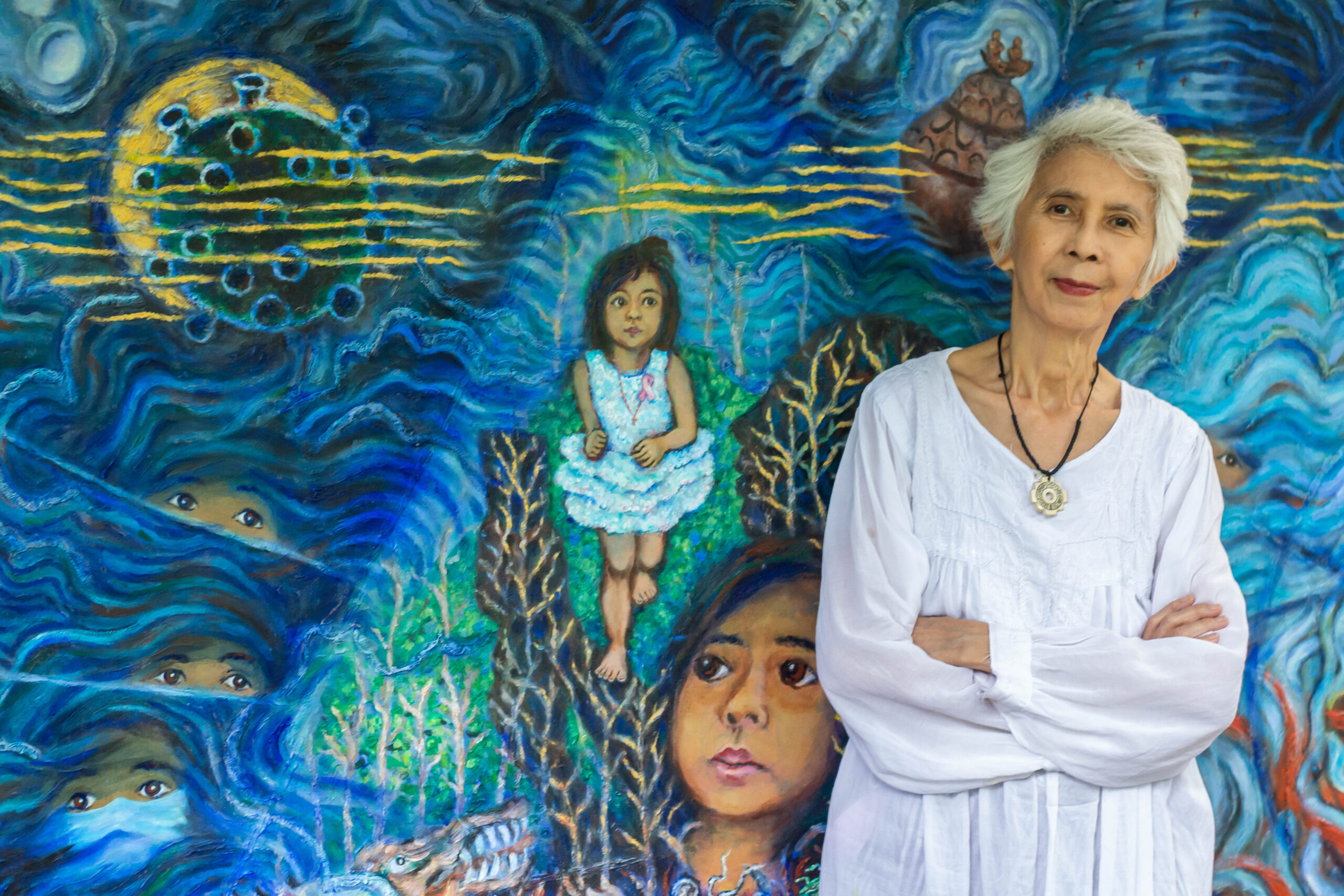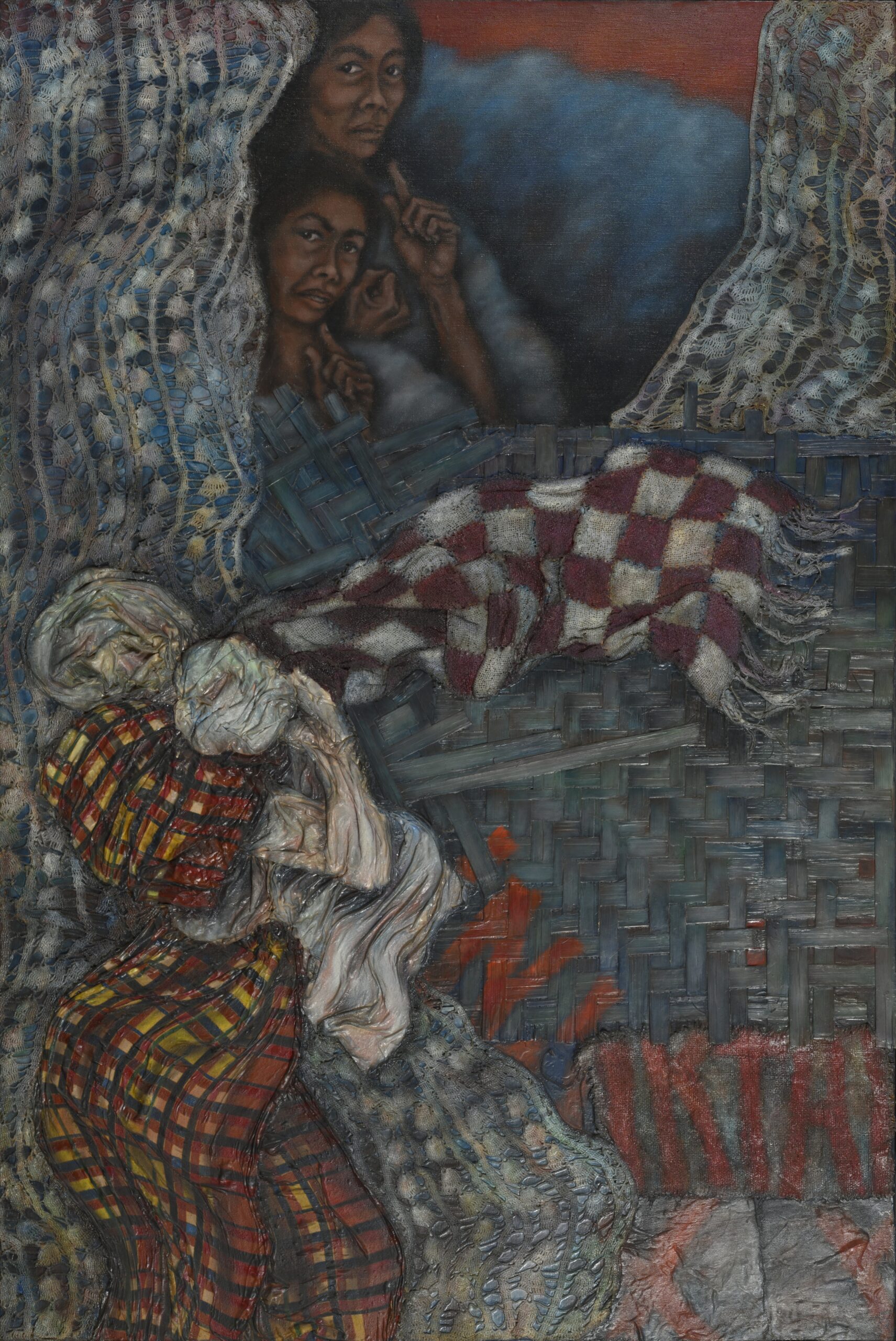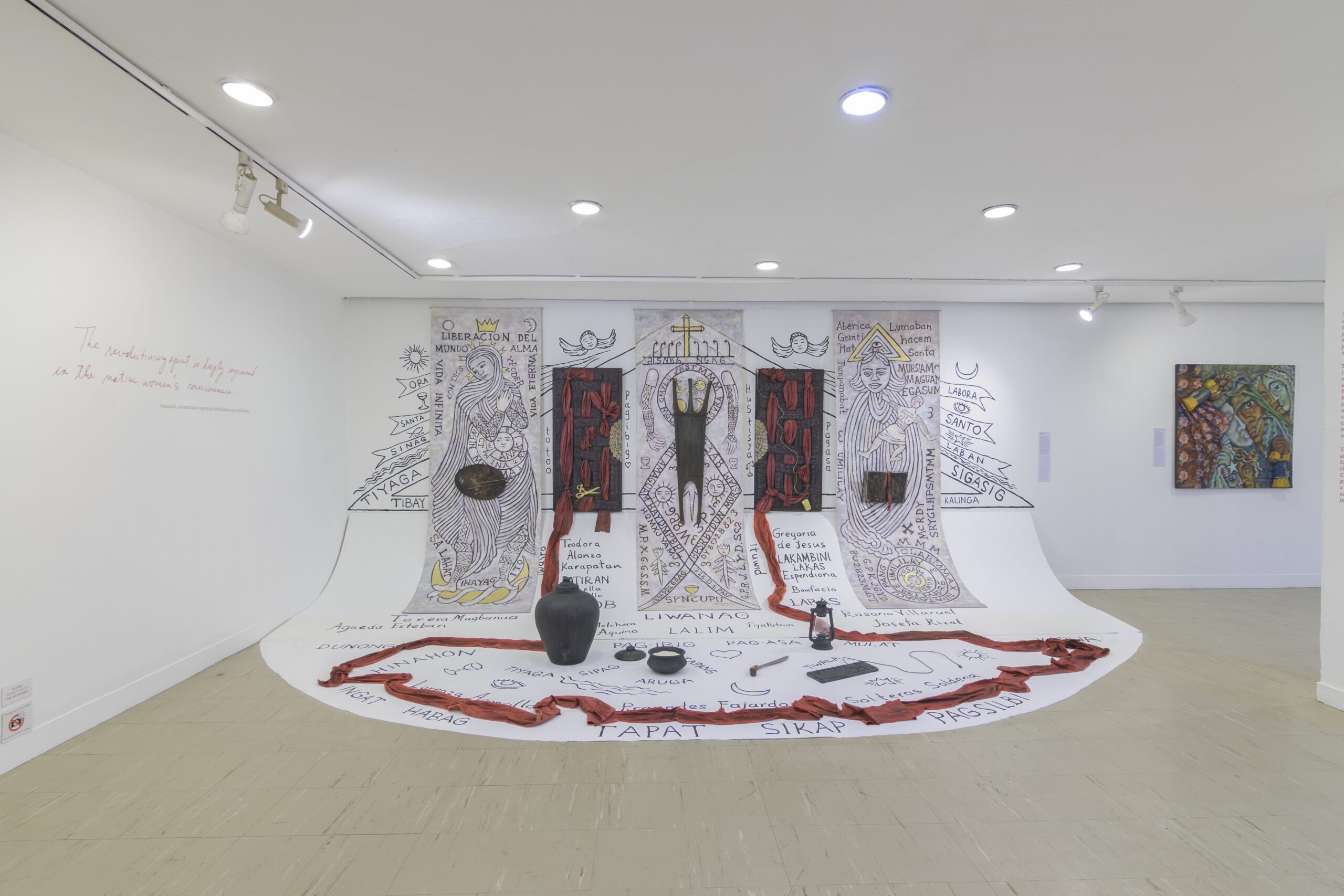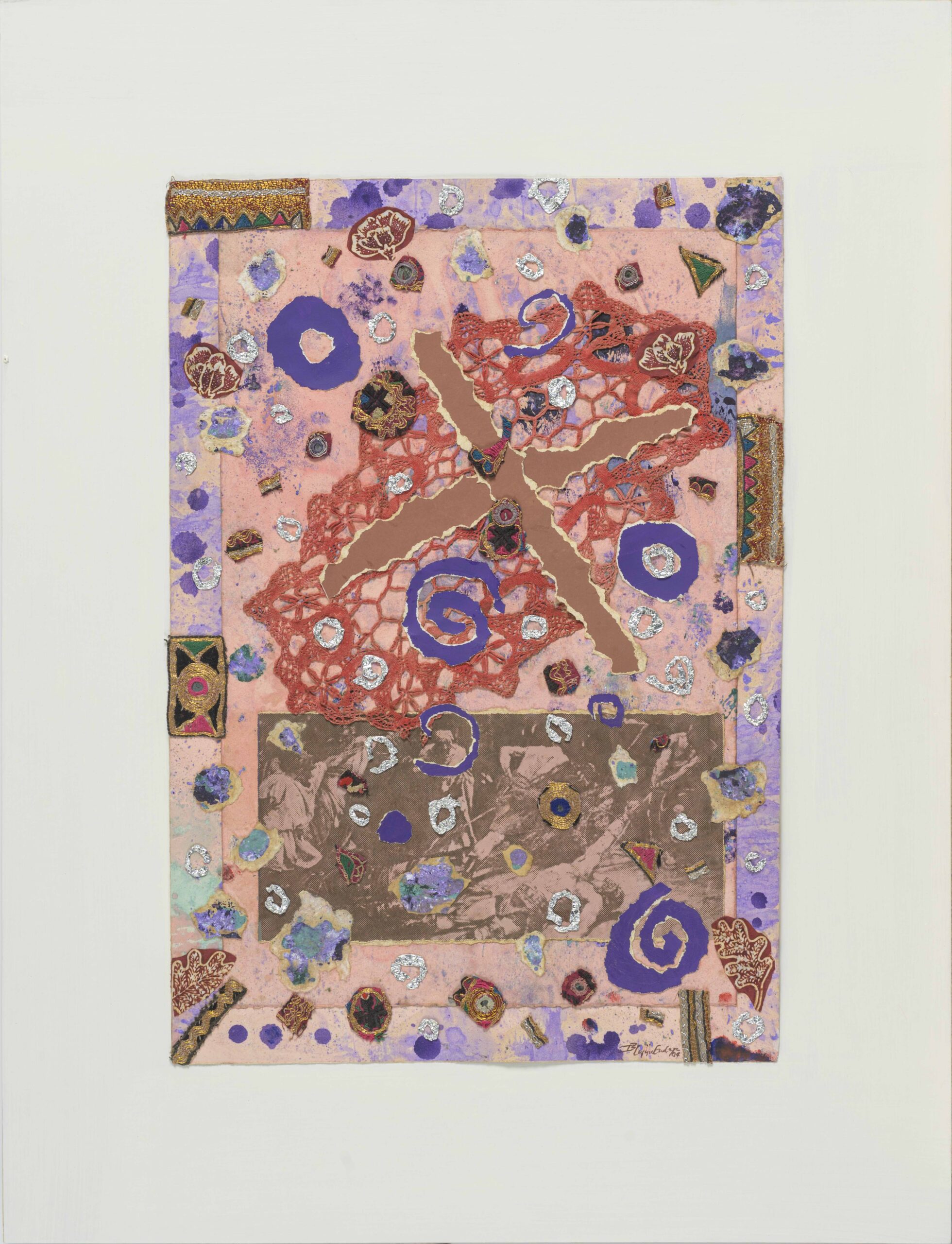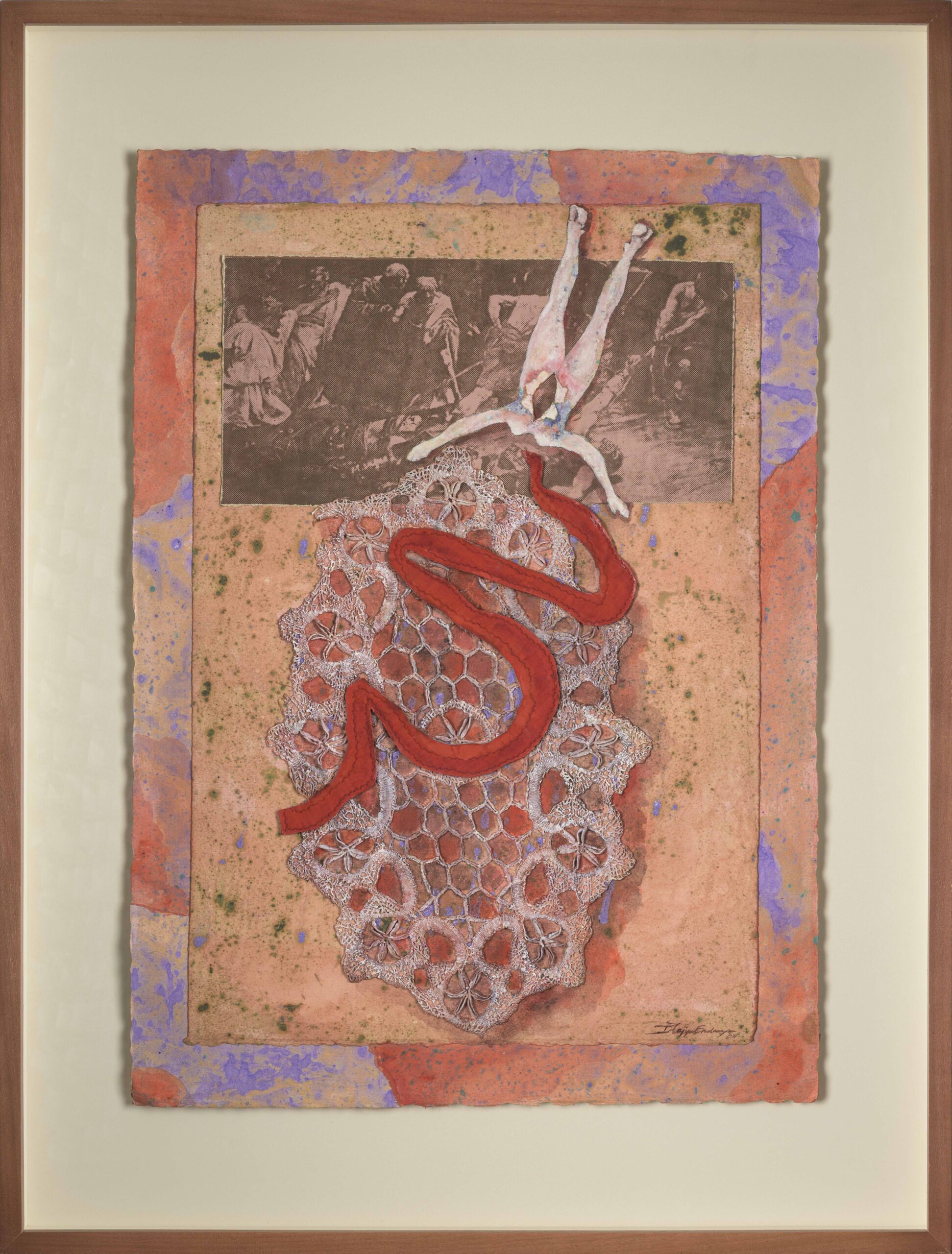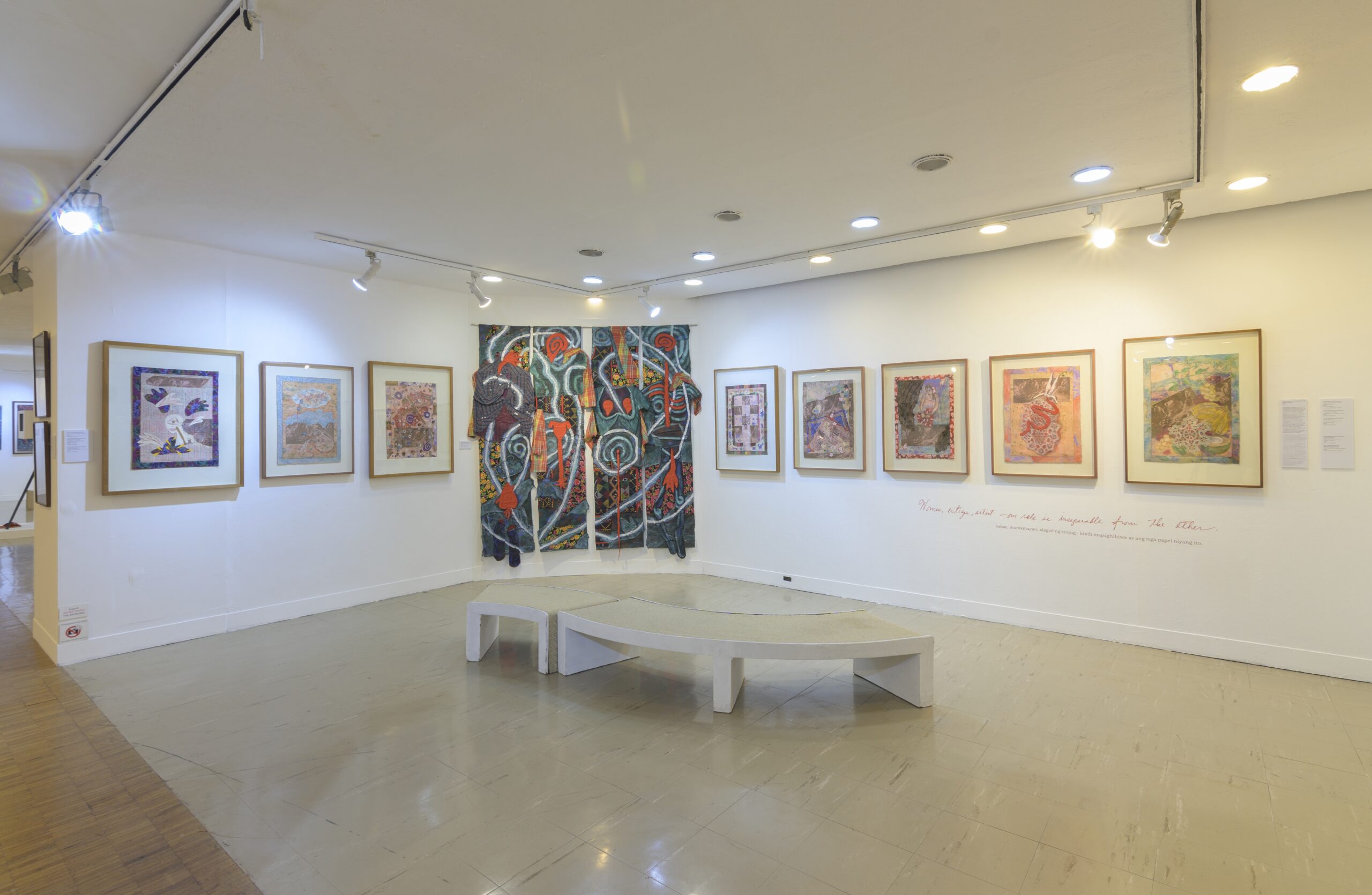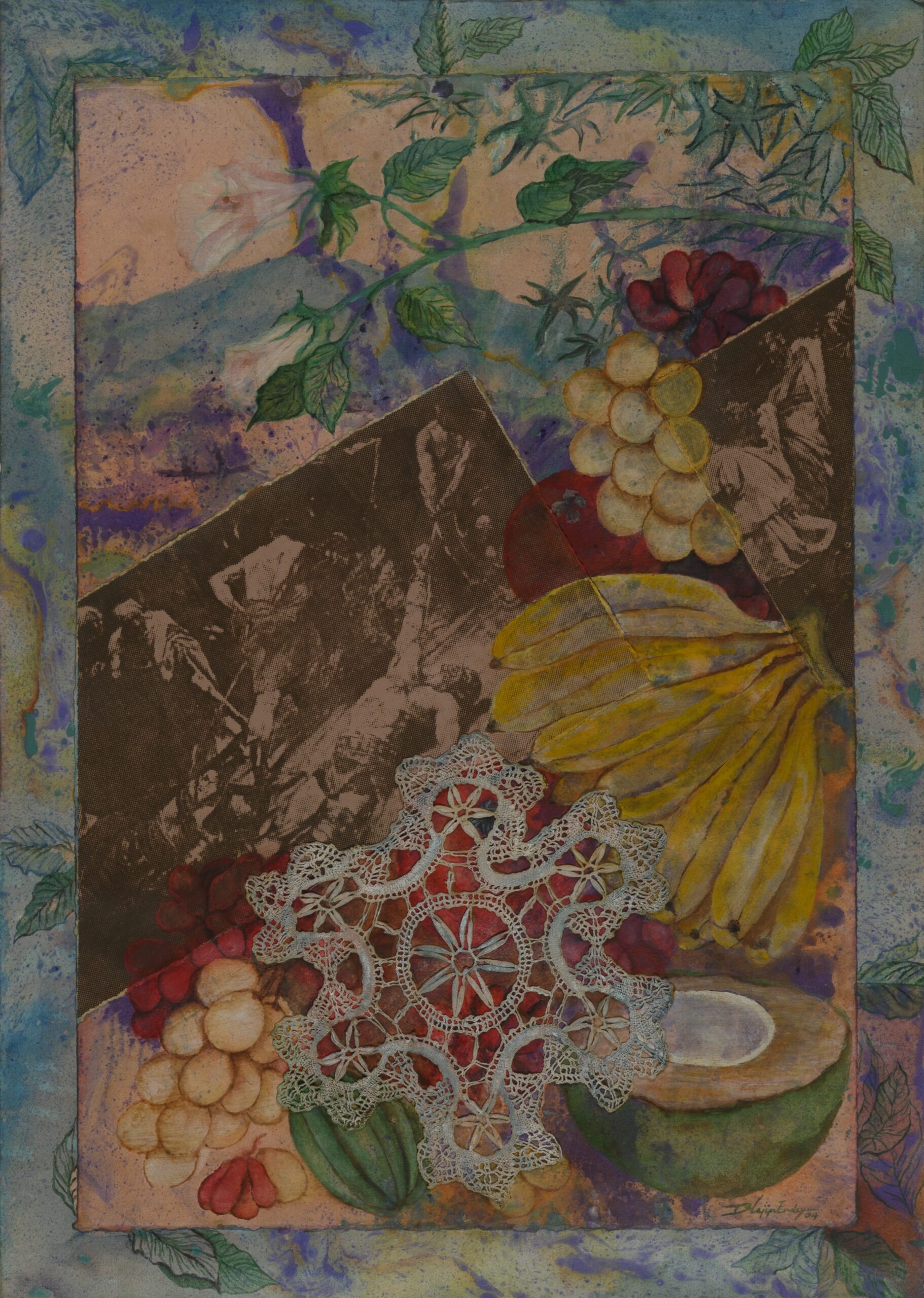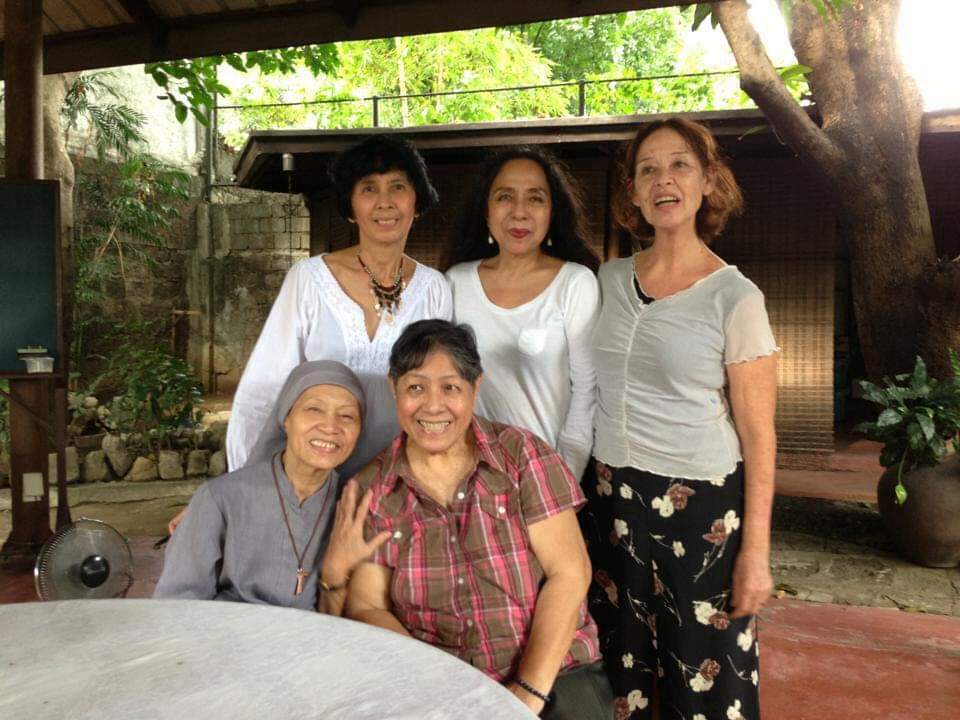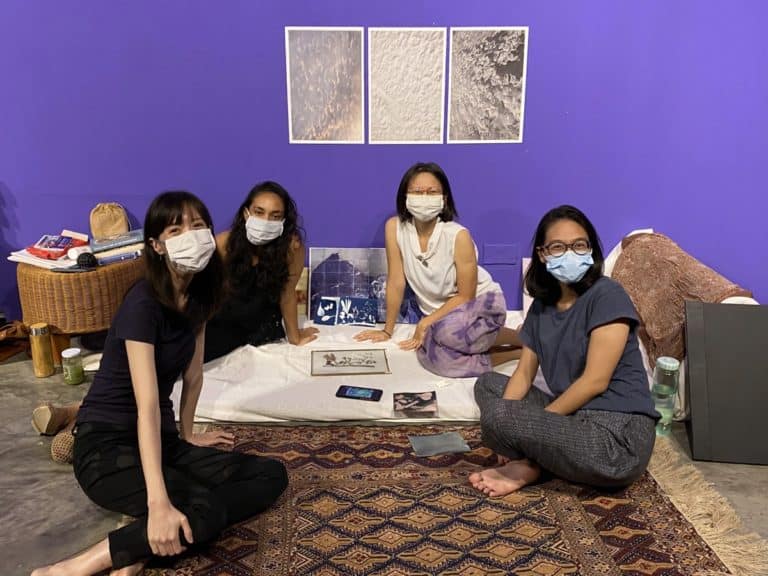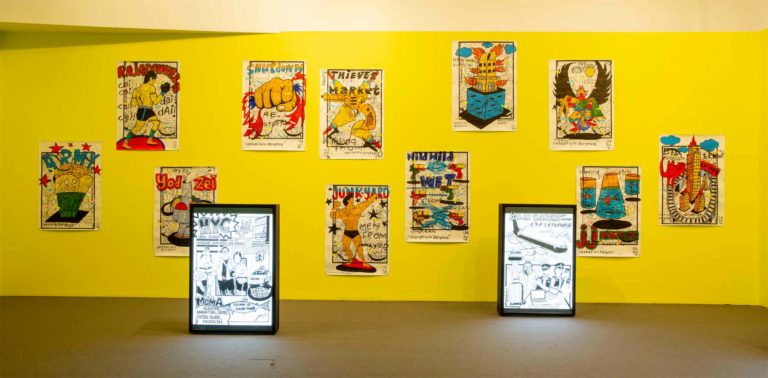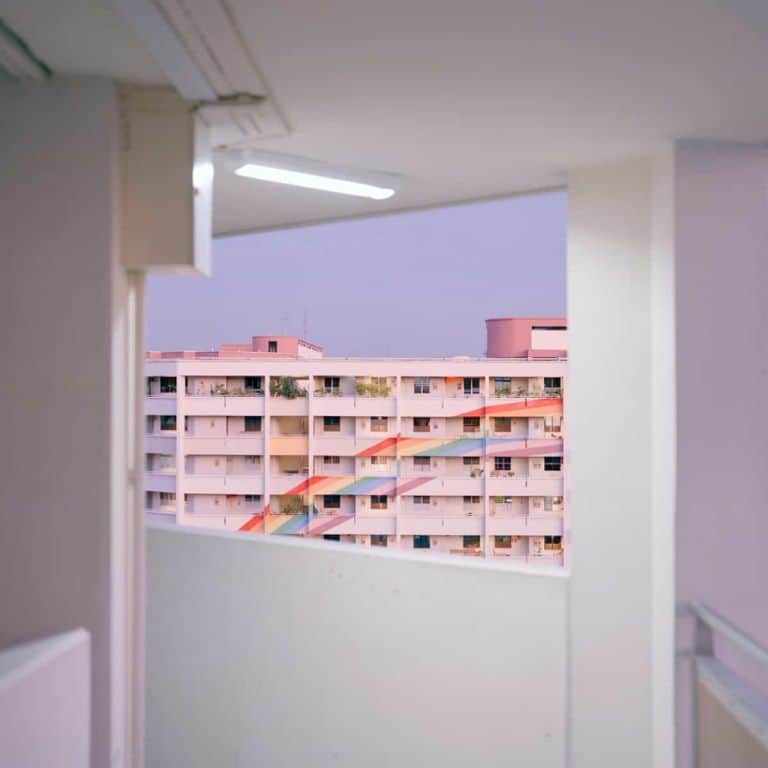In Imelda Cajipe-Endaya’s retrospective Pagtutol at Pag-Asa (Refusal and Hope), the weight of Philippine history rests on the shoulders of countless women—many of whom are unknown.
For nearly five decades, the artist has laboured to bring them to light. She has long dedicated herself to community-based work. She listens to the stories of women, especially the most vulnerable, and weaves their details into her art.
Mothers. Activists. Domestic workers. Diasporic Filipinas. Their faces and names haunt the storied halls of the Cultural Center of the Philippines (CCP), where she holds her retrospective. Large, vividly textured collages immortalise their clothes and pieces of their homes—vestiges of their toil, their care, their wild and precious lives.
Honouring unsung heroines
Filipinas take centre stage in paintings from the 1980s, a dark, politically tense time that culminated in the People Power Revolution against the late dictator Ferdinand Marcos.
In one painting, they hide behind the intricate crochet curtains and woven bamboo walls of their home. But rather than being portrayed as passive witnesses to the turmoil outside, they are shrewd participants. They raise their fingers in a hush position—as if communicating with the figures outside their window, whose heads are covered in cloth.
Taking us back to the 19th century, a grand, altar-like installation remembers the wives, mothers, daughters and sisters of the Katipuneros, a Philippine revolutionary society. These women, too, fought for freedom from Spanish colonial rule. They healed wounds. They distracted enemies. They transmitted secret documents. Cajipe-Endaya inscribes their names all over the installation, between telling objects: an oil lamp, a knife, and blood-red sheets that evoke the blankets that people once tied together to escape from prison.
Resonating with artists
But amidst these urgent, confronting works, I found myself drawn to a subtler section of the show, dedicated to Filipinas who perhaps feel closest to me: artists.
It was the homage to Pacita Abad that first caught my eye. In an abstract collage, Cajipe-Endaya replicated her richly layered aesthetic filled with circular patterns, tiny pieces of textile, and materials that shine. Her smaller, scrappier version of the late Abad’s large collages transported me to a childhood memory.
Our family had just moved from the Philippines to Singapore, and one day, my fourth-grade art teacher taught our class about Pacita Abad. She showed us a bridge that the artist painted in joyful colours even as the artist battled cancer, and told us to make vibrant artworks like hers. I remember feeling proud that she was a Filipina like me. I realise now that it was there, outside my homeland, where I first learned about a Filipina artist.
In a row of collages on the next wall, Cajipe-Endaya honours other contemporaries who emerged in the 1970s and 80s. One of them is Julie Lluch, known for her sensuous clay and terracotta sculptures. Cajipe-Endaya depicts Lluch crying as she works on a sculpture behind a lace curtain—faithful to the artist’s irreverent critiques of docile, domestic Filipina stereotypes.
Subverting Spoliarium
Next to Lluch is an ode to another celebrated sculptor, Agnes Arellano. Cajipe-Endaya references Arellano’s iconic bone-coloured sculpture of her body, headless and hanging upside down. In this collage, a red snake-like form crawls out from her neck—evoking the artist’s fascination with life that is born from destruction.
Yet, a familiar image intrudes on each of these tributes to Filipina artists. It is easy to miss at first glance, faded in their backgrounds. It is Juan Luna’s Spoliarium.
Rendered in Luna’s vigorous, romantic style, the Spoliarium is a mammoth painting of a gladiator match’s brutal aftermath. The painting was first revered for winning a Gold Medal in the 1884 Madrid Art Exposition—then, later, as a symbol for Filipinos’ grief and oppression under Spanish rule.
Today, it occupies a treasured place in the National Museum of the Philippines, and in the consciousness of every Filipino who encountered the painting in books and classes and field trips—a pervasive image of national pride.
But here, in this modest wall of Cajipe-Endaya’s retrospective, the Spoliarium takes on a different form. Its image is printed on scraps of torn paper, no larger than a postcard. A pale pink tint washes out vivid colours of flesh and blood. Stripped of its life and gravitas, it appears almost like a ghost—eternally haunting the works of these Filipinas.
The series, Cajipe-Endaya writes in her wall label, is a dialogue on male art, which is often branded as “masterpieces,” while women’s art and craft remain long invisible in art history. She writes:
“Women artists work with paint, words, images, embroidery, weaving, clay, and crafts, and often have no illusion that they are creating masterpieces.”
I could not help but smile at her playful projection of this fantasy: the “masterpiece” flattened and banished to the background; the women’s art foregrounded, alive with textures and colours and meaning, no longer in the shadows.
Lost and found legacies
One work in this particular series called out to me among the rest. A delicate still life of tropical fruits—bananas, coconut, grapes, lanzones—instantly brought me to an older time. A mountain hovers behind the fruits, rendered in that hazy, distant blue. I could not recognise the work, so I looked at the wall label, curious to find the artist’s name.
Paz Paterno. The name sounded somewhat familiar. I turned to one of CCP’s interns, Justine, who had graciously accompanied me as I navigated the show. I said the artist’s name out loud.
“Who was she again?”
Justine shrugged. She didn’t know her either.
“Paz . . .” I froze. Wait. Was this Paz, Juan Luna’s wife?
All I knew about Juan Luna’s wife was that he murdered her.
They lived in Paris at the time, and her life did not seem to matter to the French courts—who acquitted Luna on the grounds that this was a “crime of passion”. Nor does it seem to matter to us, Filipinos, who still hail Luna a hero in spite of this.
I later learned that Paz Paterno was not, in fact, Juan Luna’s wife. That was a different Paz: Paz Pardo de Tavera. But Paterno was nonetheless one of Luna’s contemporaries. Scholar Eloisa Hernandez suggests that she was the most prolific Filipina artist of the 19th century—but Google her name, and only two or three paintings appear.
In her work Still Life, chiaroscuro light illuminates lush, meticulously rendered fruits. Flora frames a faraway mountain view, just like in Cajipe-Endaya’s version. Another work, Still Life with a Bird, similarly melds still life and landscape. These scenes are so idyllic, so serene, they almost feel otherworldly.
Yet, as I gaze at them longer, I sense a tinge of melancholy—a quiet ache for those distant landscapes.
Little is written about Paterno’s life, but this is what we know: She was born in 1867. She hailed from a family of art patrons. She trained under the tutelage of respected painters Lorenzo Gurrero, Feliz Martinez and Teodoro Buenaventura. But she never studied formally, because at the time, the Academia de Dibujo y Pintura (now the University of the Philippines School of Fine Arts) still shunned women. She painted Still Life when she was 17. She was allegedly the first Filipina to paint a landscape. She never married.
Art critic Alice Coseteng wrote that, in submitting herself to rigorous artistic discipline, Paterno “[broke] through the barriers of convention and [made] herself felt in the male-dominated world of art.”
But in her seminal book Home, Body Memory: Filipina Artists in the Visual Arts, 19th Century to the Present, art historian Flaudette Datuin noted that Paterno’s social class and status as a single woman put her at an advantage, freeing her to pursue her career. Most women then married before they could flourish their art. They were burdened with caring for, quite often, more than 10 children. What they did create—pottery, textile, baskets, embroidery—was not valued as art. And yet.
Reading through Datuin’s book, I discovered a wealth of names from this period, Filipinas who found a way to create despite it all. Carmen Zaragoza y Rojas painted landscapes and won awards. Emilia del Valle taught renowned National Artist Fernando Amorsolo. Pelagia Mendoza was the first female student of the Academia de Dibujo y Pintura.
Like Luna, she won an international award—second prize at the Chicago Universal Exposition, for her bust of Christopher Columbus. Yet, when I Google her, only images of her face appear. There is no art. I learned, through Datuin’s book, that her works were destroyed after the Second World War. My heart sank.
How many more Pazs and Carmens and Emilias and Pelagias have we lost to history? How many more eclipsed by the legacy of a man who killed his wife?
What remains today
To this day, there is no Filipina National Artist in the Visual Arts. But thanks to women like Cajipe-Endaya, Filipina artists today enjoy more visibility than they did in Paterno’s time.
Cajipe-Endaya co-founded the KASIBULAN, a feminist art collective that emerged at the height of political turmoil in the 1980s. Together with artists Brenda Fajardo, Anna Fer, Ida Bugayong, and Julie Lluch, she provided a platform for female artists to grow.
She continues to inspire the next generation of artists through her powerful, accessible art, exposing the plight of everyday Filipinas. Yet, she is also human. She can only do so much.
She can leave traces of an artist’s bright colours. Or her satirical self-portraits. Or her graceful, meticulous brushwork. But it’s our duty to hold these traces — to uncover their stories, and treasure them like we would a long-lost sister.
____________________________________
Feature Image: Portrait of Imelda Cajipe Endaya by Abdullah Ali Mapandi. Image credit: Cultural Center of the Philippines.
Pagtutol at Pag-Asa (Refusal and Hope) runs at the Cultural Center of the Philippines (CCP) until 4 December 2022. Click here to find out more.
Learn more about KASIBULAN here.
